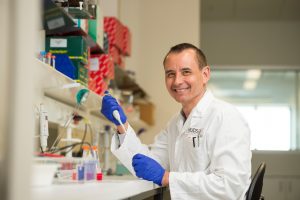Dr Simon Chu from Hudson Institute has been researching cancer cells for some time. What started as a PhD focused on tumour cell biology, has evolved into a large research program dedicated to increasing knowledge, improving the diagnosis and exploring new treatment options for women diagnosed with a rare form of ovarian cancer.

Dr Simon Chu (Image credit – Hudson Institute of Medical Research).
The specific cancer Dr Chu is researching is called a Granulosa Cell Tumour, more simply known as GCT. These rare ovarian cancers are endocrine tumours – meaning they make and respond to hormones.
Granulosa Cell Tumours (GCT) are rare.
Granulosa Cell Tumours, or GCT, account for around 5% of ovarian cancers [1]. This means around 60 women in Australia will be diagnosed with a GCT this year. While the majority of GCT (95%) are diagnosed in adults, children can also be affected. Juvenile GCT has been diagnosed in children as young as 4 months.
Granulosa cells are located in the ovarian follicle, the site in the ovary where oocytes (eggs) mature. These cells support the oocytes by producing the hormones estrogen and inhibin, which help them develop.
GCT arise from granulosa cells. These tumours remain hormonally active – meaning they continue to release estrogen and inhibin. This is why high levels of estrogen and inhibin, or symptoms caused by high estrogen, are a hallmark sign of GCT. As these are relatively easy to identify, GCT is usually diagnosed much earlier than other cancers.
GCT can normally be cured with surgery, as the cancer is slow-growing and generally confined to the ovary. Unfortunately, however, GCT commonly recurs, even up to 30 years after the primary diagnosis. If they do recur, they are usually quite aggressive, and, to date, chemotherapy has not proven effective. Although some cases appear to benefit from hormonal therapy to reduce estrogen levels, more research is needed to find a treatment that is effective for all GCTs.
Large grant will support research into adult and juvenile GCT
Conducting research for rare conditions is notoriously difficult. Having few people affected by a disease means there is little information available to identify common features and trends. It also means there are few samples available to study. Layered on top of this is the difficulty attracting research funding, as conditions that affect more people are often prioritised for access to the limited pool of national medical research funds.
This makes the recent announcement of $2.2 million from the Medical Research Future Fund (MRFF) for Dr Simon Chu and his colleagues’ research into GCT even more meaningful.
Together with partner organisations, the Ovarian Cancer Research Foundation, Victorian Cancer Agency and Monash Partners Comprehensive Cancer Consortium, Dr Chu and his team at Hudson Institute will explore GCT from several angles. These include:
- Patient outcomes – working with GCT patients and survivors to identify common features, and understand the lived-in experience and treatment journey,
- Genomics – using gene sequencing to identify genes, mutations and pathways that lead to GCT and poor outcomes,
- Molecular studies – to understand how the gene mutations cause GCT,
- Developing a new, sensitive diagnostic test for use in pathology centres around the world,
- Testing new combination drug treatments – informed by an understanding of the molecules and gene mutations associated with GCT.
Some of this work is a continuation of Dr Chu’s past research using molecular studies and genetic sequencing to understand more about GCT and potential ways to treat this disease. He is particularly focussing on the genetic changes that occur between the primary stage and when the tumour returns [2]. He hopes this will lead to understanding why some GCT returns and what makes them so aggressive. This information can accelerate efforts to find new effective treatment strategies, particularly for use in advanced stages of the disease.
“Getting this grant is a godsend,” explains Dr Chu. “I really believe we are on the cusp of being able to provide women with GCT real hope for their future and also to any other person who gets this disease. This grant will allow us to get to that next level”.
Rare Ovarian Cancer patient groups get involved in research
Helping to understand the lived experience of women diagnosed with rare ovarian cancers are two patient groups who contacted Dr Chu about his research. These groups have now become actively involved in supporting the research process and ensuring important questions are addressed.
The first is Rare Ovarian Cancer Inc (ROCInc), a charity founded by Tasha Armour, who is now helping lead this research.
“I am very pleased and excited about working with a consumer advocate on this grant,” Dr Chu says of Tasha. “Tasha is such a dynamic person, driven to find an answer. Her energy and passion motivate the whole team.”
When Tasha’s daughter was diagnosed with a rare ovarian cancer, she was mortified to find that no research was being conducted into this condition. Tasha then established ROCInc, with the aim of raising awareness and money for the much-needed research into rare ovarian cancers. Tasha has now established a world-wide network of women affected by Rare Ovarian Cancers, who regularly send Dr Chu samples for research.
The ‘GCT Survivor Sisters’, a closed Facebook group of around 1200 women around the world affected by GCT, were also keen to be involved, and contribute their stories and knowledge to increase clinical understanding of GCT. With funding from the MRFF grant, this can now be achieved.
The information provided by the GCT Survivor Sisters will result in the largest compilation of data about GCT in the world. This is a much-needed resource for women, their families and their treating doctors to understand more about this condition.
Research passion is driven by patient interaction

Image credit – Hudson Institute of Medical Research
While working on an uncommon cancer is not without its challenges, Dr Chu also recognises its rewards.
“It isn’t uncommon to get an email from a patient with a newly diagnosed tumour. They search online and find that there are only a few people around the world working on rare ovarian cancers, and they contact us to find out if there is anything we can do or recommend.”
“It is amazing how tremendously motivating that person to person contact is – to know that there are many people out there for whom our work really means something. We are working hard and really hoping to make that difference.”
————————-
Dr Simon Chu PhD is the Head of the Hormone Cancer Therapeutics research laboratory at Hudson Institute. The GCT team includes Professor Peter Fuller AM (Hudson Institute of Medical Research and Monash Health), Professor Thomas Jobling (Monash Health), Professor Victoria White (Deakin University), Associate Professor David Powell (Monash University), Professor John Silke (Walter and Eliza Hall Institute of Medical Research) and Ms Natasha Armour (Rare Ovarian Cancer Incorporated).
References
- Khosla, D., et al., Ovarian granulosa cell tumor: clinical features, treatment, outcome, and prognostic factors. N Am J Med Sci, 2014. 6(3): p. 133-8.
- Alexiadis, M., et al., Transcriptomic analysis of stage 1 versus advanced adult granulosa cell tumors. Oncotarget, 2016. 7(12): p. 14207-19.







